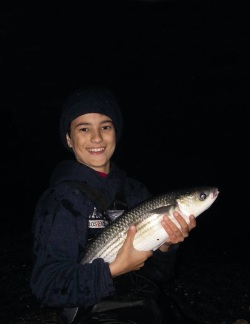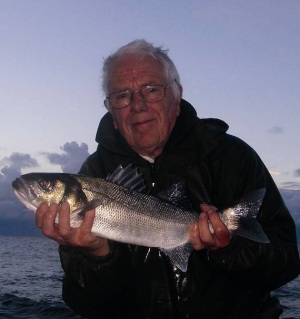You are here
Simple Shore Fishing in The South West
If you fish in rivers and lakes your main problem – finding the fish – is more or less solved, you know that (unless they have climbed out onto dry land) they are in there somewhere. Sea angling is an entirely different ball game. Your quarry has the entire Atlantic Ocean to swim in and might well be many miles from your chosen spot – tricky! On the credit side there will be many species to choose from – wrasse, pollack, cod, bream, mackerel, scad, bass, mullet, conger, dogfish, flounder, etc., etc., – take your pick!
Each species has its own preferred menu and will select the best times and places to dine, so where do you start? Muddy harbours and estuaries, sandy or gravelly beaches, rocky weedy coasts and piers or breakwaters, all have their own attractions.
Believe it or not you don’t need special rods and reels to cope with these different fish and conditions. Yes, you can buy expensive tailor made tackle but you can catch plenty of good fish with the simplest of gear.
The tackle you use for carp, barbel, perch, chub, trout and the like together with a spool of braided line and a small assortment of nylon, hooks, weights, floats and lures will be more than adequate for catching most of our saltwater species. Armed with this I’d be confident of taking some fantastic fish from the seashore. Let’s look at one or two examples –
The coastline is rocky and weedy with deep gulleys separated by ledges, prime ground for wrasse, pollack and bass. You get up early in the morning (before it gets light), grab the spinning gear, tie a white plastic eel with a waggy tail on to the end of a one yard trace of 20lb nylon and creep down to the water’s edge. 
Taking care to avoid dangerous swells or being cut off by the rising tide you perch yourself on a handy ledge and begin to cast. Was that a bump on the line? Next cast, a yank on the rod top suggests that it was a bite. You hook a fish that plunges down into the kelp. After a bit of a tug of war you see the gleaming bronze body of a nice pollack caught in the beam of your head torch, fantastic!
Over the next ten minutes one pollack after another battles its way to your net. One, a bit bigger than the rest, snags you in the kelp and you have to replace the lure. First light is beginning to appear in the eastern sky. You cast your replacement lure about twenty yards out and begin to retrieve. Wallop! You’re into a much livelier fish which boils and thrashes on the surface between a series of clutch screaming runs. You reach down with the net to land a beautiful silver bass.
By now the first rays of sunlight trace a golden path across the sea. As you slip the bass back you notice a few swirls on the calm surface. Flick the lure out again and as it approaches it is harassed by a small shoal of ripple marked mackerel. Quickly switch to a little silver spoon and one mackerel after another darts at the fast moving metal ‘leaf’.
Some are hooked and tear away in a typical fast jinking fight. You keep a couple for breakfast – there’s nothing tastier.
The next cast produces a leaping, green-backed, snake-like garfish. After you return it you notice that your hand is plastered with bright green scales. A few more casts – nothing! The fish have gone, but you’re well pleased with your two hour session. Twenty fish of four species and home in time for breakfast!
In contrast, if you’d chosen to fish a sandy or shingly beach instead of the rocks you could have used exactly the same tackle but this time it might have been armed with a couple of ounces of lead and a dropper bearing a size six circle or semi-circle hook baited with a lugworm, ragworm or soft crab. In daytime you’d have landed flounders, plaice or dabs – each one a tasty meal. Fishing later on at dusk there would be even less need to cast far – perhaps ten or fifteen metres at most. As darkness fell the knock, knock bites of the pouting and poor cod would begin and you might wish that you had brought more bait with you.
Switch to a bigger hook, bait it with a whole calamari, remove the lead (yes no lead) and lob it close to the rocks at the end of the beach. After a couple of minutes there is a fierce yank on the rod tip and the braid begins to race out through your fingers. You flick the bale arm over and allow the line to draw tight. It’s on! The reel screams as a big bass tears out to sea – glorious!
It’s a hot sunny day. You want to fish from the pier or the harbour wall – again you can use the same rod and reel. You’ve noticed the big grey shapes of thick lipped mullet plucking filaments of algae from the stonework. This time you’ll need a bit of a white loaf for bait. Slip a float or even a small cork slit with a razor blade onto the line and add a trace of six pound nylon armed with a size ten hook.
A couple of small split shot carry the pinch of bread close to the wall. Crumble a bit of bread and trickle it down by the stonework. Make sure that if you hook a fish you have some handy steps to get you down to the water to land it. The float dips and you’re into a big mullet. Jeez can they go! It’s probably five minutes or more before you can slide it into the meshes. By baiting with worms you might catch several kinds of wrasse, blennies or even bass (they are widespread) and strips of fish may attract mackerel or garfish.
Whatever the venue – pier, rocks, beach or river mouth – just for a change you could try spinning with a plug. Use a floating shallow diver. Just cast it out and wind steadily – about one turn of the reel handle per second should be OK. As you retrieve the lure dives down a foot or so – well above the top of the waving kelp and rugged rocks – again the change of light is often good. Bass, mackerel, garfish and pollack will all have a go at these fishlike lures. If there’s a decent current you may not even have to cast, just drop the lure in and let it drift away until you’re ready to wind it back. Take it steady the flow will make the lure work. The bites are often fierce and the excitement is intense. Even more of an adrenaline rush comes from the use of surface poppers. Chuck them out and bring them back by short bursts of reeling with pauses in between. The bass often hurl themselves from the water to take the lure – heart stopping action.
Of course there will be times when a gale is blowing, the sea is rough, the water is dirty and many places seem ‘unfishable’ with your light tackle.

You could try heavy bottom fishing gear when it’s like this and it may produce good fish. However, there’s generally a sheltered bay or inlet somewhere that would suit your ‘normal’ tackle. If it’s very weedy after a storm the best answer may be to spin a ‘weedless’ soft plastic bait. The bass and pollack love these eel-like creations and you can easily fish them through what amounts to seaweed soup.
There’s lots of scope for innovation in sea fishing. It’s common these days for sea anglers in the south and south west to be carrying fly rods. Bass can be suckers for a Clouser minnow and surface feeding mullet will take an imitation maggot fished dry.
You can forget distance casting and nailing your bait to the sea bed. Big fish are often much closer than you think. Keep it simple, keep it close and above all keep your eyes peeled for action, believe me you won’t be disappointed.
Find much more information about sea angling in the southwest on Dr Mike Ladle’s website
www.mikeladle.com
